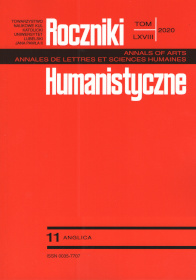“Beautiful And Terrible”: The Ambiguity of the Grid and Suburban Space in D. J. Waldie’s Holy Land: A Suburban Memoir
Abstrakt
„Piękna i okropna”: dwuznaczność siatki i przedmieść w Holy Land: A Suburban Memoir D. J. Waldiego
Artykuł omawia wspomnienia D. J. Waldiego zatytułowane Holy Land: A Suburban Memoir (1996), uznając je za odpowiedź na zgorzkniały sposób prezentacji amerykańskich przedmieść, będących miejscami alienacji. Dowodzę, iż Waldie, opisując Lakewood w Kalifornii jako miejsce święte, czyli podmiejską siatkę osiedli, odrzuca dominujące w amerykańskiej kulturze opowieści o przestrzeni. Wywód rozpoczyna analiza tego, jak Waldie analizuje wcześniejsze prace krytyczne poświęcone przedmieściom. Następnie analizuję dwoistą postawę wywołaną przez podmiejską siatkę w autorze. Artykuł kończy refleksja nad potencjalnym statusem Waldiego jako pisarza post-zachodniego; wysuwam argument, iż jego opis życia na przedmieściach unika stereotypów obecnych w narodowej świadomości Amerykanów – przedmieścia albo jako raju dla osób pnących się po drabinie społecznej albo bezdusznego miejsca alienacji.
Bibliografia
Baumgartner, M. P. The Moral Order of a Suburb. Oxford UP, 1989.
Beuka, Robert. SuburbiaNation: Reading Suburban Landscape in Twentieth-Century American Fiction and Film. Palgrave Macmillan, 2004.
Blake, Peter. God’s Own Junkyard: The Planned Deterioration of America’s Landscape. Holt, Rinehart and Winston, 1964.
Buchanan, Ian. Michel de Certeau: Cultural Theorist. SAGE Publications, 2000.
Campbell, Neil. “‘The Compass of Possibilities’: Re-Mapping the Suburbs of Los Angeles in the Writings of D. J. Waldie.” European Journal of American Studies, vol. 6, no. 3, 2011, pp. 1–15. DOI:10.4000/ejas.9424.
Campbell, Neil. The Rhizomatic West: Representing the American West in a Transnational, Global, Media Age. U of Nebraska P, 2008.
Certeau, Michel de. The Practice of Everyday Life. U of California P, 1988.
Comer, Krista. Landscapes of the New West: Gender and Geography in Contemporary Women’s Writing. UNC Press Books, 1999.
Didion, Joan. Where I Was From. New ed., Harper Perennial, 2004.
Fishman, Robert. Bourgeois Utopias. The Rise and Fall of Suburbia. Basic Books, 1987.
Jackson, John B. A Sense of Place, a Sense of Time. Yale UP, 1994.
Jackson, Kenneth T. Crabgrass Frontier: The Suburbanization of the United States. EPUB, Oxford UP, 1985.
Johnson, Tom M. “Lakewood: Portraits of a Sacred American Suburb.” Western American Literature, vol. 46, no. 3, 2011, pp. 272–80. DOI:10.1353/wal.2011.0057.
Kelly, Barbara M. “Expanding the American Dream.” The Suburb Reader, edited by Becky Nicolaides and Andrew Wiese, Taylor and Francis, 2006, pp. 284–90.
Kenyon, Amy Maria. Dreaming Suburbia: Detroit and the Production of Postwar Space and Culture. Wayne State UP, 2004.
Kunstler, James Howard. The Geography of Nowhere: The Rise and Decline of America’s Man-Made Landscape. Simon & Schuster, 1994.
Mitchell, William J. T. Landscape and Power. U of Chicago P, 2002.
Mumford, Lewis. The City in History. Harcourt Brace Jovanovich, 1961.
Relph, Edward C. Place and Placelessness. Pion, 1976.
Sharpe, William, and Leonard Wallock. “Bold New City or Built-Up 'Burb? Redefining Contemporary Suburbia.” American Quarterly, vol. 46, no. 1, 1994, pp. 1–30.
Tuan, Yi-Fu. Space and Place: The Perspective of Experience. U of Minnesota P, 2011.
Turner, Frederick Jackson. The Frontier in American History. U of Arizona P, 1986.
Turner Smith, Carissa. “D. J. Waldie’s Holy Land: Redeeming the Spiritual Geography of Suburbia.” REN, vol. 64, no. 4, 2011, pp. 307–24.
Venturi, Robert, et al. Learning from Las Vegas: The Forgotten Symbolism of Architectural Form. MIT Press, 1988.
Waldie, D. J. Holy Land: A Suburban Memoir. W. W. Norton & Company, 2005.
Waldie, D. J., and Neil Campbell. “‘An Assemblage of Habits’: D. J. Waldie and Neil Campbell—A Suburban Conversation.” Western American Literature, vol. 46, no. 3, 2011, pp. 228–49. DOI:10.1353/wal.2011.0066.
Copyright (c) 2020 Roczniki Humanistyczne

Utwór dostępny jest na licencji Creative Commons Uznanie autorstwa – Użycie niekomercyjne – Bez utworów zależnych 4.0 Międzynarodowe.





